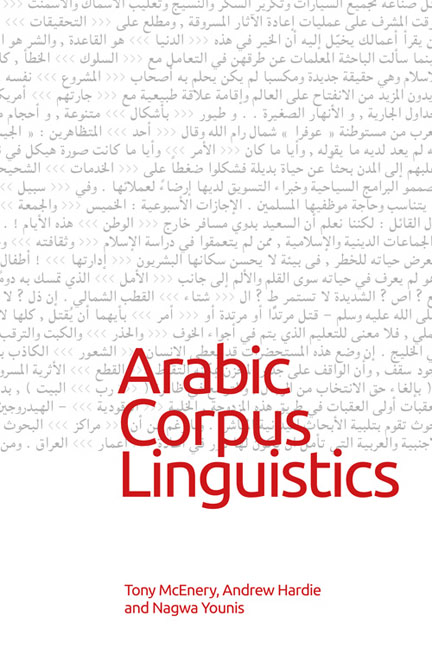Book contents
- Frontmatter
- Contents
- Notes on Contributors
- 1 Introducing Arabic Corpus Linguistics
- 2 Under the Hood of arabiCorpus
- 3 Tunisian Arabic Corpus: Creating a Written Corpus of an ‘Unwritten’ Language
- 4 Accessible Corpus Annotation for Arabic
- 5 The Leeds Arabic Discourse Treebank: Guidelines for Annotating Discourse Connectives and Relations
- 6 Using the Web to Model Modern and Qurʾanic Arabic
- 7 Semantic Prosody as a Tool for Translating Prepositions in the Holy Qurʾan: A Corpus-Based Analysis
- 8 A Relational Approach to Modern Literary Arabic Conditional Clauses
- 9 Quantitative Approaches to Analysing come Constructions in Modern Standard Arabic
- 10 Approaching Text Typology through Cluster Analysis in Arabic
- Appendix: Arabic Transliteration Systems Used in This Book
- Index
5 - The Leeds Arabic Discourse Treebank: Guidelines for Annotating Discourse Connectives and Relations
Published online by Cambridge University Press: 11 November 2020
- Frontmatter
- Contents
- Notes on Contributors
- 1 Introducing Arabic Corpus Linguistics
- 2 Under the Hood of arabiCorpus
- 3 Tunisian Arabic Corpus: Creating a Written Corpus of an ‘Unwritten’ Language
- 4 Accessible Corpus Annotation for Arabic
- 5 The Leeds Arabic Discourse Treebank: Guidelines for Annotating Discourse Connectives and Relations
- 6 Using the Web to Model Modern and Qurʾanic Arabic
- 7 Semantic Prosody as a Tool for Translating Prepositions in the Holy Qurʾan: A Corpus-Based Analysis
- 8 A Relational Approach to Modern Literary Arabic Conditional Clauses
- 9 Quantitative Approaches to Analysing come Constructions in Modern Standard Arabic
- 10 Approaching Text Typology through Cluster Analysis in Arabic
- Appendix: Arabic Transliteration Systems Used in This Book
- Index
Summary
Introduction
In the last two decades, advanced discourse studies have tended to use annotated corpora to obtain a complete empirical view of contemporary usage of the language. In addition, these corpora have been used as a basis for the automatic discovery of discourse relations, especially for English. However, discourse annotation remains an attractive but challenging field for the natural language processing (NLP) community when it comes to widely used languages other than English. One such language is Arabic.
Arabic remains a challenging language in many respects for linguistic and computational linguistic studies. Arabic has a complex morphology, many local dialects, and free word order. It allows the construction of a full clause or sentence using only one token.
Existing Arabic corpora include collections of unannotated written texts and/or spoken scripts, such as the Arabic Gigaword (Parker et al. 2011) or the King Saud University Corpus of Classical Arabic (KSUCCA); corpora with syntactic and/or morphological annotation, such as the Arabic Treebank (Maamouri et al. 2004); and resources for lexical and semantic relationships (Arabic WordNet). However, none of these include annotation of the discourse features of discourse units.
We present the first empirical attempt to annotate Arabic text with discourse features, namely the Leeds Arabic Discourse Treebank (LADTB). This corpus contains annotations for all of the explicit discourse connectives in the Penn Arabic Treebank Part 1 (Maamouri et al. 2004), their arguments, and the discourse relations they convey.
We base our annotation guidelines for the LADTB on the same principles as the (English) Penn Discourse Treebank but adapt and expand the annotation to take into account properties specific to Arabic. Using similar principles for annotation allows us to advance comparative studies and thus our understanding of the two languages. Discourse relations are semantic relations, such as causality, contrast, and temporality, which connect two textual units, typically clauses or sentences. The textual units connected should express abstract objects, such as events, actions, facts, or beliefs, and are called arguments of the discourse relation. There are two types of discourse relations: (1) relations that are signalled explicitly via so-called discourse connectives, such as coordinating or subordinating conjunctions or discourse adverbials (explicit relations); and (2) relations that can be inferred from the context without any explicit signalling (implicit relations). Both are illustrated in the example below.
- Type
- Chapter
- Information
- Arabic Corpus Linguistics , pp. 76 - 99Publisher: Edinburgh University PressPrint publication year: 2018

